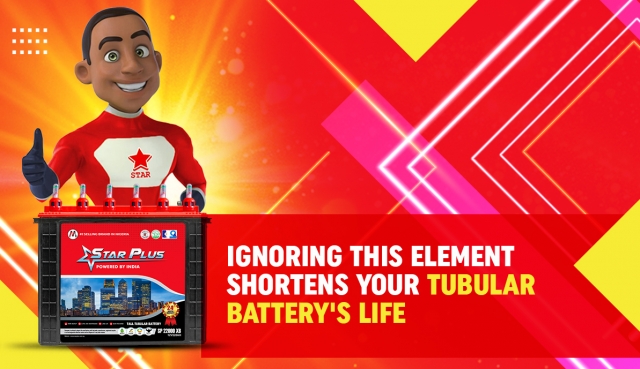Batteries don't scream for help. They just die—usually when you need them most. One minute everything's running fine, and the next, you're staring at a dead inverter. It's frustrating, unexpected, and avoidable. Yes, avoidable. Most battery failures have one hidden villain: neglecting a simple but powerful maintenance habit.
The Silent Killer - Water Neglect
What's Water Got to Do With It?
Distilled water is your tubular battery's best friend. Not tap water. Not mineral water. Only distilled. Without it, the internal plates dry out faster than gossip at a family function. And once they dry, they can't carry or store a charge effectively.
Water inside the battery acts like a bridge. It connects the chemical reactions that create power. When the water level drops, this chemical dance slows down. The result? Weak power output and long charging times.
Ignoring water levels is like skipping oil changes in a car. The machine might run, but not for long. Regular top-ups keep your battery happy, healthy, and shockingly long-lasting.
The Chemistry of Trouble
Every time your battery charges and discharges, water inside evaporates a little. That's normal. But not checking levels for weeks? That's battery suicide. Over time, this dries out the electrolytes, increases sulfation, and reduces capacity. In short, the battery dies slowly and painfully.
This issue becomes worse in hotter climates. The warmer it gets, the faster your battery loses water. And guess what most people forget during summer? Exactly.
Too little water also exposes the battery plates to air. This causes them to corrode. Corroded plates can no longer hold a proper charge. So even if your inverter says it's charging, the battery won't back you up when the lights go out.
Bold move: Buying tubular batteries without learning about water levels is like buying a pet and forgetting to feed it.
The Maintenance Myths That Cost You
“It's Maintenance-Free!” No, It's Not.
Some dealers will say it. “This one's maintenance-free.” That's code for “You'll forget about it until it fails.” Even the best tubular batteries need attention. Just because they're stronger doesn't mean they're invincible.
A quick check every month can extend the battery's life by years. Yes, years. Pop the caps. Check the water. Fill up if needed. It takes less than five minutes and saves you a fortune.
If you're thinking “I'll do it later,” remember this: Dead batteries don't wait.
Also, keep an eye on the battery terminals. Loose terminals or dirty ones create heat and voltage drops. Over time, this heat causes the battery to lose water even faster. Clean terminals mean smoother power flow and less stress on the battery.
Overcharging and Undercharging: The Hidden Culprits
Too much or too little charging messes with water levels. An overcharged battery loses water faster. An undercharged one lets sulfate crystals form. Both shorten battery life, no matter how premium your tubular batteries are.
Overcharging happens when your inverter fails to stop charging at the right point. This boils the water, releasing gases, and leaves the plates dry. Undercharging, on the other hand, leaves chemical reactions incomplete. This leads to flaky buildup on the plates, making them less efficient.
Get a good-quality inverter. Cheap ones overcharge like they're frying an egg. A smart inverter protects both your battery and your patience.
Look for models with automatic water-level indicators. They'll nag you politely. Way better than a dead inverter during your online meeting.
Heat, Dust, and Other Silent Enemies
The Enemy Called Heat
Your battery hates heat. High temperatures speed up water evaporation. That's double trouble: faster water loss and faster wear. Keep your tubular batteries for inverter in a cool, well-ventilated spot. The corner near your kitchen stove? Not ideal.
Heat also increases internal resistance in the battery. That means your inverter has to work harder, and the battery drains quicker. Over time, this reduces overall efficiency.
Avoid keeping the battery in closed cupboards. No airflow means it heats up more. And heat? It's the slow poison for battery life.
Covering your battery with a cloth may look tidy. But it's also a heat trap. Let it breathe. Literally.
If possible, place your battery setup on a raised surface. This prevents heat from the floor from building up and also protects it from accidental spills or flooding.
Dirt Doesn't Just Sit There
Dust looks innocent. It isn't. When dust collects on your battery terminals, it causes leakage current. Over time, this eats into performance and damages connections. Always keep the terminals clean and tightly fixed.
Use a soft cloth or brush to wipe off dust every couple of weeks. Apply petroleum jelly to terminals. This slows down rust and improves contact. Clean battery = longer life.
Also, don't let moisture build up around the battery. If the floor gets wet often, it increases the chance of an electrical discharge. That's bad for the battery and risky for you.
It's like skincare for batteries. Clean, moisturized, and glowing.
Using It Right – The Daily Habits That Matter
Don't Overload It
If your battery were a person, it would beg you not to run that washing machine during a power cut. Tubular batteries for inverter are tough but not bodybuilders. Stick to essentials: lights, fans, maybe the Wi-Fi. Forget the fridge and microwave.
Overloading strains the battery. It discharges faster, heats up more, and loses water quicker. That's a fast-track route to battery heaven (and your wallet's hell).
Check your inverter's wattage capacity. Know what's connected. Less is more when it comes to load.
If you really need to power heavy appliances, consider using two tubular batteries in parallel. This distributes the load and prevents overheating or fast draining.
Regular Use Is Better Than Occasional Bursts
Inverters and batteries are like being used. If your area doesn't face regular power cuts, use the inverter once in a while. Run it for 15–30 minutes. Let the battery stretch its legs.
This helps maintain a good charge-discharge cycle. It also gives you a chance to spot problems early.
A well-used battery stays sharp. Just like muscles, it needs activity to stay in shape.
Note to self: Treat tubular batteries for inverter like plants. Use, water, clean, repeat.
Don't forget to fully recharge after each use. Partial charging leaves the battery weaker over time. Always let it reach full charge to keep it strong.
Conclusion: One Small Habit, One Giant Life Boost
One habit. That's all it takes to extend your battery's life. Check water levels once a month. That's it. No rocket science. No toolkit required.
Don't wait till your inverter stops in the middle of a cricket match or your Zoom call. Show your battery some love. It works hard for you. Keep it cool, clean, and hydrated.
Because nothing ruins a good day like a silent inverter and a dead battery.






